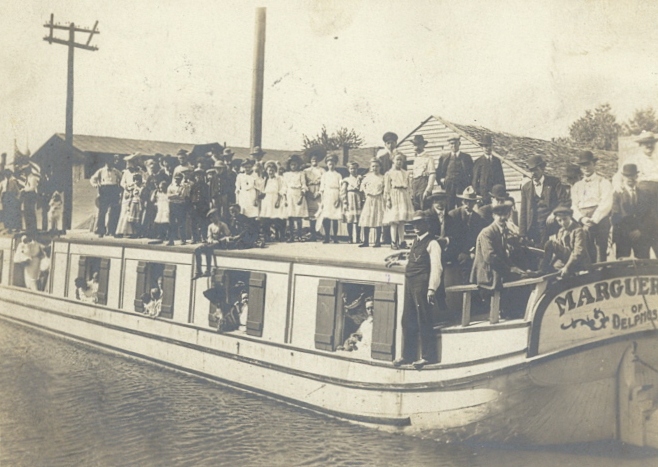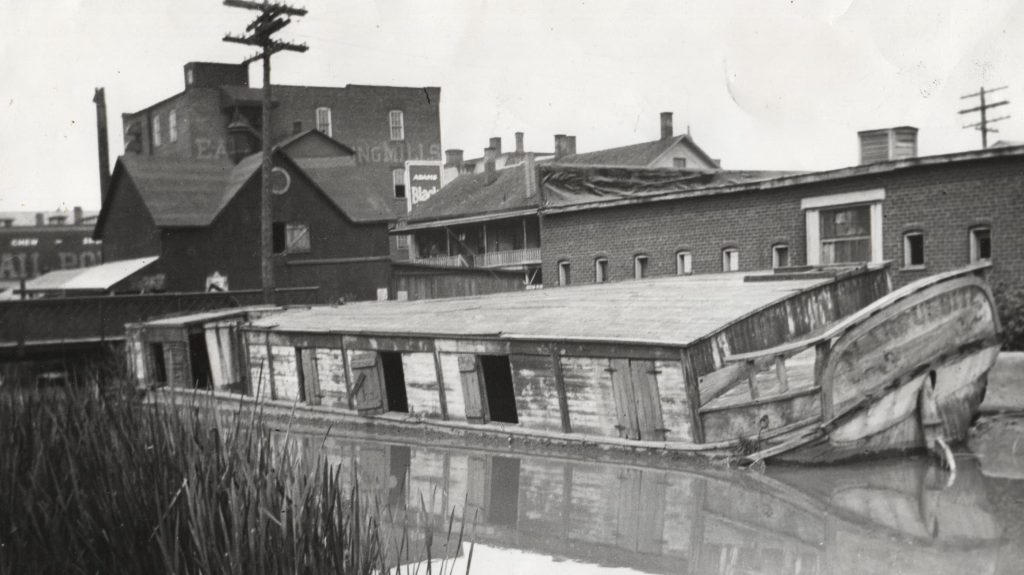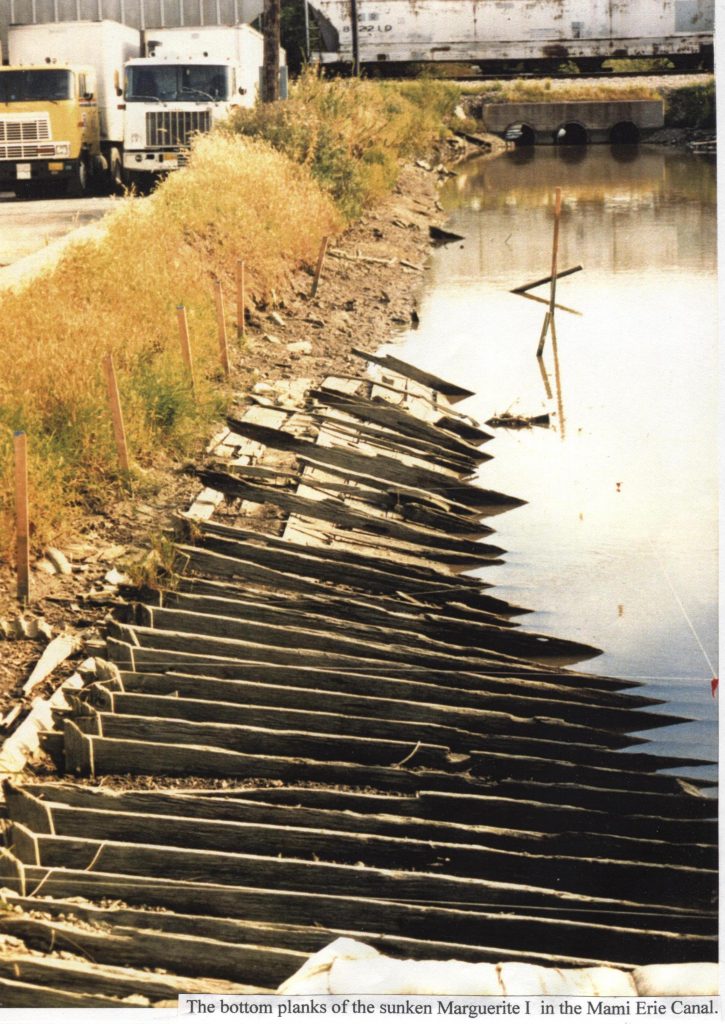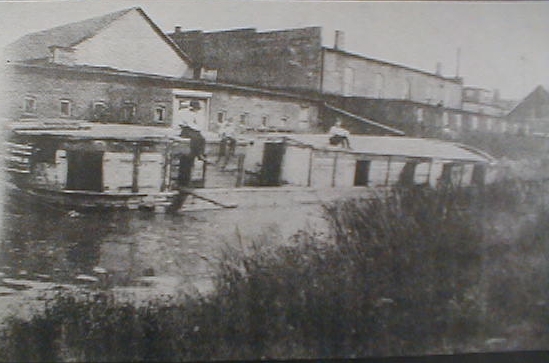She was born in the middle of the 19th century, the creation of a builder whose engineering skills likely consisted mostly of knowing how to use a hammer and a saw. Christened the Marguerite, this simple, wooden canal boat spent her life gliding through western Ohio on the waters of the Miami and Erie Canal. She carried passengers and cargo from village to village, and sometimes to the big cities of Cincinnati and Toledo, at the gentle speed of four miles per hour. Through her efforts the wilderness of western Ohio was slowly being replaced by farms and roads and growing communities.
As the years passed, her voyages became less frequent and the number of fellow boats on the canal’s placid waters slowly decreased. The Marguerite and the canal were being replaced by steel and steam. A web of railroads was quickly covering Ohio, ironically being supplied with rails and steam engines by the very canal boats they were replacing. Her trips on the canal were reduced to local cargo hauling and pleasure trips. In 1913 a disastrous rain storm inundated Ohio, covering much of the state with destructive flood waters. In an effort to reduce the damage, integral parts of the Miami and Erie Canal, mainly locks and aqueducts, were destroyed, often totally obliterated by dynamite. The destruction hemmed in the Marguerite, limiting her range to only a few miles in each direction from Delphos. Finally, only a few years after the disastrous flood, lift and swing bridges over the canal, old and difficult to operate, were permanently closed. The Marguerite was trapped. The old lady of the canal was moored between First Street and the Pennsylvania Railroad and left to her fate. She became a playground for local children, a good fishing spot and a temporary home for transients passing through Delphos. Lack of maintenance eventually sent the old gal to the bottom of the canal and a subsequent fire reduced her to a charred hull barely peaking above the waterline. Lost and forgotten, her old bones settled into the soft mud of the canal bottom and were slowly covered by silt.
Jump ahead to the 1980’s. Dredging in the canal has altered water flow and the Marguerite’s remains are slowly being lifted from their resting place to above the waterline and into view of the modern world. A local youth group, the Columbian Squires, while cleaning brush and debris from the canal banks, noticed the rising timbers and with youthful curiosity began to ask questions. They questioned their group’s advisor, Fr. Chris Vasko, about the timbers. After an examination of the debris, Fr. Vasko declared to his young Squires that there was a canal boat in those waters! The young men of the Squires were stricken with canal boat fever and soon a project to rescue the remains, dubbed Raise the Lady, was formed.
From January to June of 1987 the young men of the Squires, ages 16-9 years old, began researching the Marguerite and the proper methods to extract her from her decades-long resting place. Not only was education needed to complete this project, permission was necessary as well. Permits were needed from the State of Ohio to make the site safe and suitable for excavation and to allow for removal of the remains from state property. The Ohio Department of Natural Resources eventually granted permission to lower the water level in the canal to allow for an archaeological dig and to allow the removal of the Marguerite’s remains. However, the Squires were required to complete their ambitious project in a short, 15 day window beginning August 30.
The dig finally began on August 30, 1987. A coffer dam had been built south of the excavation site and when the control dam to the north was opened, the water slowly began to recede and the full majesty of the Marguerite began to appear. The Lady was more than 72 feet long and nearly 12 feet wide. Parts of the aft quarter and much of the bow had been damaged or destroyed by various canal maintenance projects over the decades. The amateur archaeologists, with careful adult supervision, began their project by first examining the newly exposed canal bed surrounding the Marguerite and carefully recording any artifacts found there. Finally, the removal of the boat from the canal was set to begin. After exhaustive preparation, at 10:30am on September 5, the recovery team entered the site and carefully began to remove each timber, tagging it and recording its position. At the end of each day, timbers were removed to storage, treated with preservatives and given permanent identification tags. As first the ribs and then the planks of the keel were removed, the newly exposed canal bed was examined for additional artifacts. The last timbers to be removed, the keel planks, measured ten to fourteen feet in length, a foot wide and two inches thick, and were saturated, leaving them slippery, heavy and extremely pliable. To prevent damage, they were carefully hoisted onto the canal bank to allow water to drain overnight. The next day they were transported to storage, tagged and treated. After removal of all artifacts and timbers, the site was subsequently cleaned, restored and the canal re-watered. The Marguerite’s timbers continued to be treated with preservative for many months to ensure their long term viability. Phase One of Raise the Lady was complete.
A generation passes and the Delphos Canal Commission, formed from the original Raise the Lady project, now has a well-established museum in downtown Delphos showcasing the city’s rich history. In 2013 the Museum finally has the space and resources to bring the Lady home. The Marguerite’s well preserved ribs and planks are transported from storage to the Museum’s main floor. Over the ensuing months, trustees and volunteers at the Museum spend countless hours planning and constructing an exhibit showcasing the remains of an authentic 19th century canal boat. Thanks to careful tagging by the young archaeologists in 1987, the preserved timbers are able to be positioned in the exhibit as they were found in the canal. Additional construction of key components of canal boats such as the captain’s cabin and the addition of educational signage help tell the story of the Marguerite and the Miami and Erie Canal during its 19th century heyday. The entire exhibit is greatly enhanced by a beautiful mural of Lock 24, an original stone lock located in Stadium Park on Delphos’ north end. The exhibit is constructed as to allow visitors to “walk the deck” of the Marguerite as she prepares to “lock through” Lock 24 on her way into Delphos. The Marguerite exhibit will be formally dedicated on Sunday, October 12. The Museum will open at 1:00pm with a short program to begin at 1:15pm. Monsignor Chris Vasko, who was instrumental in the Raise the Lady project, will give a short history of the Marguerite and her voyage from Mud to Museum. Mayor Mike Gallmeier will also present a proclamation on the Marguerite exhibit. The public is invited to experience the exhibit, enjoy light refreshments and view the rest of the exhibits of Delphos’ history. Special, commemorative items will be available for purchase and can be stamped with the official dedication date.

















Speak Your Mind